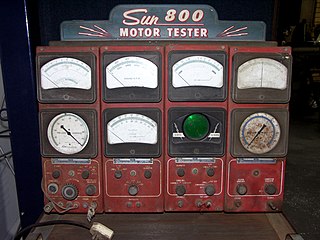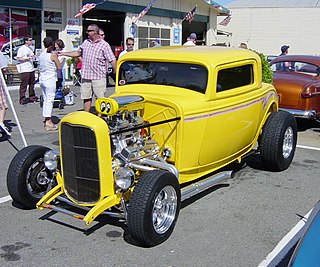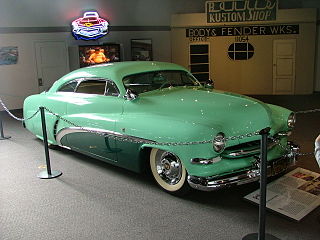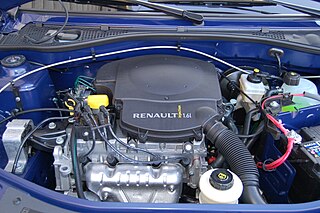
Auto racing is a motorsport involving the racing of automobiles for competition.

Muscle car is an American term for high-performance cars, usually but not limited to rear-wheel drive and fitted with a large and powerful V8 engine. The term originated for 1960s and early 1970s special editions of mass-production cars which were designed for drag racing.

Engine tuning is the adjustment or modification of the internal combustion engine or Engine Control Unit (ECU) to yield optimal performance and increase the engine's power output, economy, or durability. These goals may be mutually exclusive; an engine may be de-tuned with respect to output power in exchange for better economy or longer engine life due to lessened stress on engine components.

Hot rods are typically old, classic or modern American cars with large engines modified for faster speed. The origin of the term "hot rod" is unclear. For example, some claim that the term "hot" refers to the vehicle being stolen. Other origin stories include replacing the engine's camshaft or "rod" with a higher performance version. Hot rods were favorites for greasers.

The Ford Small Block is a series of automobile V8 engines built by the Ford Motor Company beginning in July 1961. The engine was discontinued in new trucks (F-Series) after 1996, and new SUVs (Explorer) after 2001, but remains available for purchase from Ford Racing and Performance Parts as a crate engine. The "Windsor" designation is an enthusiast designation applied for the family of engines sharing a common basic engine block design. The Windsor designation was adopted to distinguish the 351 cu in (5.8 L) version from the Cleveland 335-family engine that had the same displacement, but a significantly different configuration. The designations of 'Windsor' and 'Cleveland' were derived from the locations of manufacture: Windsor, Ontario and Cleveland, Ohio.

The Chevrolet "Big Block" is a term for a series of large displacement V8 engines that have been developed and produced in the United States from the 1950s until 2009. As American automobiles grew in size and weight following the Second World War, the engines powering them had to keep pace. Chevrolet had introduced its popular small block V8 in 1955, but needed something larger to power its medium duty trucks and the heavier cars that were on the drawing board.

The Chevrolet small-block engine is a series of V8 automobile engines used in normal production by the Chevrolet division of General Motors between 1954 and 2003, using the same basic engine block. Referred to as a "small-block" for its comparative size relative to the physically much larger Chevrolet big-block engines, the family spanned from 262 cu in (4.3 L) to 400 cu in (6.6 L) in displacement. Engineer Ed Cole is credited with leading the design for this engine.

The Iron Duke engine is a 151 cu in (2.5 L) Straight-4 piston engine built by the Pontiac Motor Division of General Motors from 1977 to 1993. Thereafter GM's 2.2 L OHV 4-cylinder replaced it across the entire lineup of vehicles that offered it. Although its original purpose was to serve as Pontiac's new economy car engine it was later adapted for use in wide variety of applications across GM's lineup in the 1980s.

The Shelby Mustang is a high-performance variant of the Ford Mustang which was built by Shelby American from 1965 to 1968, and from 1969 to 1970 by Ford. Following the introduction of the fifth generation Ford Mustang in 2005, the Shelby nameplate was revived as a new high-performance model, this time designed and built by Ford.

The Ford flathead V8 is a V8 engine of the valve-in-block type designed by the Ford Motor Company and built by Ford and various licensees. During the engine's first decade of production, when overhead-valve engines were rare, it was usually known simply as the Ford V‑8, and the first car model in which it was installed, the Model 18, was often called simply the "Ford V‑8", after its new engine. Although the V8 configuration was not new when the Ford V8 was introduced in 1932, the latter was a market first in the respect that it made an 8-cylinder affordable and a V engine affordable to the emerging mass market consumer for the first time. It was the first independently designed and built V8 engine produced by Ford for mass production, and it ranks as one of the company's most important developments. A fascination with ever-more-powerful engines was perhaps the most salient aspect of the American car and truck market for a half century, from 1923 until 1973. The engine was intended to be used for big passenger cars and trucks; it was installed in such until 1953, making the engine's 21-year production run for the U.S. consumer market longer than the 19-year run of the Ford Model T engine for that market. The engine was on Ward's list of the 10 best engines of the 20th century. It was a staple of hot rodders in the 1950s, and it remains famous in the classic car hobbies even today, despite the huge variety of other popular V8s that followed.

The modern definition of a "rat rod" is a custom car with a deliberately worn-down, unfinished appearance, typically lacking paint, showing rust, and made from cheap or cast-off parts. These parts can include non-automotive items that have been repurposed, such as using a rifle as a gear shifter, wrenches as door handles, and old saws as sun visors. A rat rod may or may not have extraneous decorations, but will always exude a great deal of personality due to the imagination required of the builder.

Specialty Equipment Market Association (SEMA) of the automobile aftermarket was formed in 1963 by Roy Richter, Els Lohn, Willie Garner, Bob Hedman, Robert E. Wyman, John Bartlett, Phil Weiand Jr, Al Segal, Dean Moon, and Vic Edelbrock Jr. and now consists of 6,383 companies worldwide, bringing together aftermarket manufacturers, original equipment manufacturers (OEM), media, car dealers, specialty equipment distributors, installers, retailers and restoration specialists.

A custom car is a passenger vehicle that has been either substantially altered to improve its performance, often by altering or replacing the engine and transmission; made into a personal "styling" statement, using paint work and aftermarket accessories to make the car look unlike any car as delivered from the factory; or some combination of both. A desire among some automotive enthusiasts in the United States is to push "styling and performance a step beyond the showroom floor - to truly craft an automobile of one's own." A custom car in British according to Collins English Dictionary is built to the buyer's own specifications.

Sport compact is an American car classification for a high-performance version of an affordable compact car or a subcompact car. There is no precise definition and the description is applied for marketing purposes to a wide variety of models.
Chevrolet Performance is an automotive performance parts brand that sells everything from camshafts and cylinder heads to high-performance crate engines and high-performance vehicles. It was founded in 1967 to support the Trans-Am Camaro race teams. Chevrolet Performance was formed as a way to support all the various Trans Am teams across the United States, but the brand saw enough of a demand to start selling the high-performance parts to the general public. Today, Chevrolet Performance not only sells performance parts, but also helps develop Chevrolet’s high-performance vehicles and supports teams in nearly every form of automotive racing.

Devin Enterprises was an American automotive manufacturer that operated from 1955 to 1964. Devin was mainly known for producing high quality fiberglass car bodies that were sold as kits, but they also produced automotive accessories as well as complete automobiles. The company was founded by Bill Devin.

A V8 engine is an eight-cylinder V configuration engine with the cylinders mounted on the crankcase in two sets of four, with all eight pistons driving a common crankshaft. Most banks are set at a right angle (90°) to each other, some at a narrower angle, with 45°, 60°, and 72° most common.

Hamann Motorsport GmbH is a German car tuning company based in Laupheim. It specialises in Audi, Aston Martin, Bentley, BMW, Mini, Ferrari, Fiat, Jaguar, Land Rover, Maserati, Mercedes, Rolls Royce, Porsche and Lamborghini cars. Hamann Motorsport was founded by Richard Hamann in 1986.





















